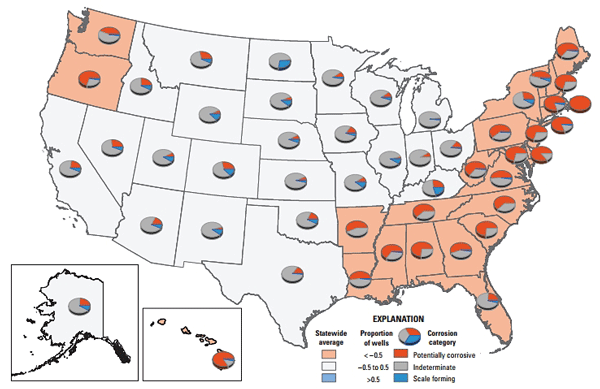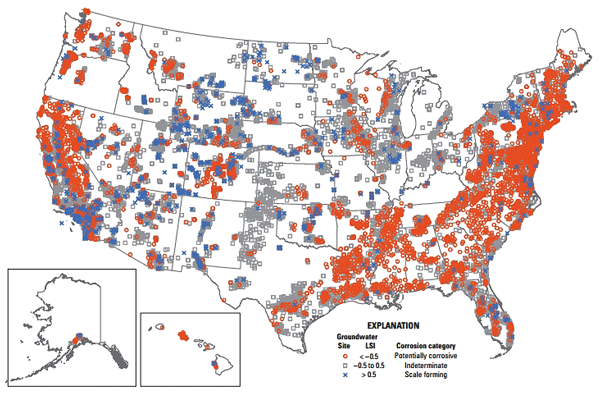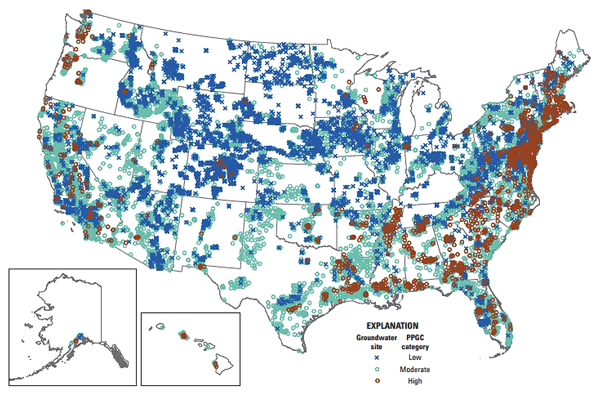A new assessment study1 by the U.S. Geological Survey (USGS) (Reston, Virginia) of more than 20,000 private wells in the United States shows that untreated groundwater in 25 states has a high prevalence of being potentially corrosive enough to leach lead from pipes.
The states with the largest percentage of wells with potentially corrosive groundwater are located mainly in the Northeast, the Southeast, and the Northwest, as shown in Figure 1.
"The corrosivity of untreated groundwater is only one of several factors that may affect the quality of household drinking water at the tap," says Don Cline, associate director for water at the USGS. "Nevertheless, it is an essential factor that should be carefully considered in testing for water quality in both public and private supplies nationwide."
Overall, potentially corrosive groundwater occurs in all 50 states and the District of Columbia, the USGS says.
While the study was conducted in the aftermath of the recent water crisis in Flint, Michigan, the new USGS study is unrelated to the problems in Flint. The problems in Flint were related to treated surface water from the Flint River, whereas this report focuses on untreated groundwater nationwide.
High-Risk Areas
Eleven U.S. states and the District of Columbia have a very high prevalence of potentially corrosive groundwater, according to the study. As many as 8 million people depend upon self-supplied groundwater in those areas.
To be designated as a very high prevalence area, a state must have scored high on both measurement indexes used in the study—the Langelier Saturation Index (LSI) and the Potential to Promote Galvanic Corrosion (PPGC).

The LSI (Figure 2) indicator is used to indicate the degree of saturation of calcium carbonate (CaCO3) in water, since the mineral is naturally present in water and acts to protect against minerals dissolving from pipes. In the absence of such protection, lead—if present—could dissolve into the water. The PPGC indicator is a three-tier classification system developed to assess levels of concern related to the galvanic corrosion of lead in water distribution systems.
On the basis of LSI, about one-third of the samples collected from nearly 21,000 groundwater sites (Figure 3) were classified as potentially corrosive. These corrosive samples are capable of dissolving lead and other metals from pipes and other components in water distribution systems, the USGS says.

For the PPGC index, galvanic corrosion of lead is defined as an electrochemical process that can occur when lead pipe or lead solder is in contact with a dissimilar metal such as copper, the USGS says.
“If the source water entering a system has a relatively elevated chloride-to-sulfate mass ratio, the potential for galvanic corrosion to occur is elevated,” the researchers say in the report.

On the basis of the PPGC index (Figure 4), about two-thirds of the samples collected from about 27,000 groundwater sites (Figure 5) were classified as having moderate PPGC potential, and about one-tenth as high PPGC potential.
Importance of Geography, Proximity to Chloride
Kenneth Belitz, one of the researchers involved in the study, explains that the USGS team has only started to look at the factors behind the corrosion. But he noted that geography and proximity to sources of chloride could be important factors.
“The rock and minerals affect chemical composition,” Belitz says. “The coastal plains on the East Coast tend to have more issues. The rainfall contributes chloride. Rain enters the ground and then it begins to move toward wells."
“As it moves through the system its chemical composition changes,” he adds. “The amount of time and the amount of rock that it has encountered will also affect the composition.”

Flaws of Private Testing
The U.S. Environmental Protection Agency (EPA) (Washington, D.C.) regulates public water supplies, but homeowners are responsible for the maintenance, testing, and treatment of private water supplies. Approximately 44 million people in the United States use drinking water from private wells, yet surveys indicate that many homeowners are unaware of basic testing that should be done to help ensure safe drinking water in the home, the USGS says.
“Fortunately, in most areas of the country and with appropriate safeguards, the majority of homeowners can get good-quality drinking water from private wells,” says Stephen Moulton II, chief of the USGS National Water-Quality Assessment Program. “But this study is a good reminder that prudent routine testing of the water, including its interaction with the water supply system, is an essential first step so homeowners and their families can confidently drink water from their faucets.”
Naturally corrosive water is not dangerous to consume by itself, the USGS says. However, it can cause health-related problems by reacting with plumbing fixtures. If the materials contain lead or copper, for instance, these metals may be leached into the water supply by corrosive water. Signs of this leaching may include bluish-green stains in sinks, a metallic taste to water, and small leaks in plumbing fixtures.
According to the USGS, potential sources of lead in homes can include:
• Lead pipe or fittings used in homes built before 1930
• Lead solder used in copper fittings in homes built before the late 1980s
• Lead-free brass components, which, in all states except for California, may have contained up to 8% lead before 2014
• Galvanized steel that contained 0.5% to 1.4% lead
“USGS has consistently monitored the water quality of the nation’s groundwater for over three decades by analyzing representative water samples,” Moulton says. “Recent public health and water quality issues underscore the responsibility for us to report the possibility that regional geologic characteristics of groundwater could potentially affect household water systems, resulting in significant implications for public health.”
State Agencies Can Assist
To further address concerns about the potential health effects of corrosive water in homes, USGS says it looks to federal and state agencies to provide an indication of the potential scope of the problem.
For example, private water sources, such as wells, springs, or cisterns, are especially common in Virginia and Pennsylvania. Approximately 1.7 million people in Virginia and 3 million people in Pennsylvania use private water systems.
In these states, the Virginia Household Water Quality Program and the Pennsylvania Master Well Owner Network distribute information to homeowners about maintaining, testing, and protecting private water systems.
University researchers at Virginia Tech (Blacksburg, Virginia) and Pennsylvania State (State College, Pennsylvania) work with these specialized programs to monitor the quality of drinking water supplied by private water systems and provide testing and advice to identify and remediate water quality problems caused by contaminated or corrosive groundwater.
“Between 2012 and 2014, we found that 19% of the 2,144 private water systems sampled in Virginia exceeded the EPA lead action level,” says Kelsey Pieper, a USDA-NIFA postdoctoral fellow at Virginia Tech. “We also observed that lead-free plumbing components released lead when exposed to more corrosive groundwater supplies.”
“In Pennsylvania, corrosive water is usually associated with certain types of bedrock geology, but can be found across the entire state,” says Bryan Swistock, a water resources specialist for Penn State Extension. “Lead levels exceeded the EPA action level in 12% of the 251 drinking water systems monitored in Pennsylvania in 2007.”
The full USGS report, Potential Corrosivity of Untreated Groundwater in the United States, can be accessed here.
Reference
1 K. Belitz, B.C. Jurgens, T.D. Johnson, “Potential Corrosivity of Untreated Groundwater in the United States,” U.S. Geological Survey, Scientific Investigations Report 2016-5092, July 2016.